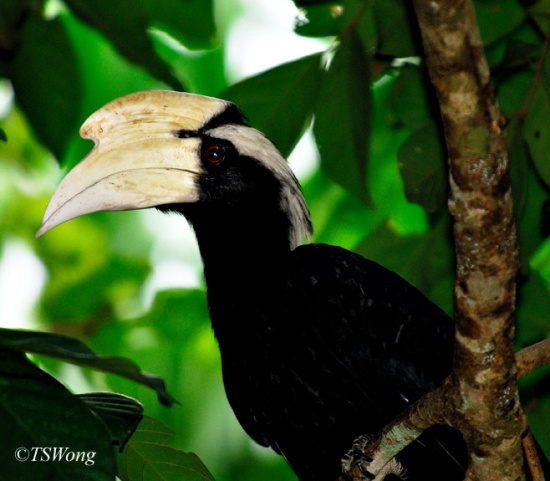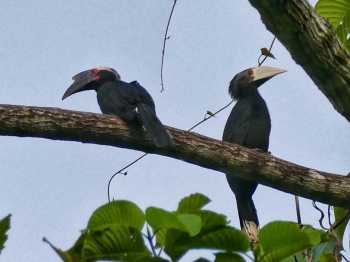Alternative names: Asian Black Hornbill; Malay Black Hornbill
- Anthracoceros malayanus
Identification
60-65cm (23½-25½) A medium-sized, blackish hornbill.
Male
- Black plumage
- Long tail with broad white tips on outer tail feathers
- White or pale grey superciliary stripe, variable, can also be dark grey or absent
- Pale yellow bill and casque
- Blue-black bare skin around eye and small throat patch
Female
- Smaller than male
- Black bill and smaller casque
- Yellowish-flesh to pinkish circumorbital skin
- Yellow-buff throat patch
Juveniles with smaller, pale green bill, small casque and dull greyish supercilium.
Distribution
From southern Thailand to Malaysia and on Sumatra and Borneo.
Locally still common but threatened by habitat loss.
Taxonomy
This is a monotypic species.[1]
Subspecies deminutus is usually considered invalid[2]
Habitat
Lowland primary evergreen forest. Usually below 200m.
Behaviour
Only rarely seen in flocks.
Diet
Feeds mainly on fruit but takes also grasshoppers, locusts, small reptiles and amphibians. Catches also bats.
Forages in middle and lower levels of forest.
Breeding
Little known. Nests in a natural cavity or an old woodpecker hole in a tree.
Vocalisation
Not as noisy as the other Hornbills
References
- Clements, J. F., T. S. Schulenberg, M. J. Iliff, S. M. Billerman, T. A. Fredericks, J. A. Gerbracht, D. Lepage, B. L. Sullivan, and C. L. Wood. 2021. The eBird/Clements checklist of Birds of the World: v2021. Downloaded from https://www.birds.cornell.edu/clementschecklist/download/
- Avibase
- Del Hoyo, J, A Elliot, and J Sargatal, eds. 2001. Handbook of the Birds of the World. Volume 6: Mousebirds to Hornbills. Barcelona: Lynx Edicions. ISBN 978-8487334306
- London Zoo
- Birdforum Member observations
Recommended Citation
- BirdForum Opus contributors. (2025) Black Hornbill. In: BirdForum, the forum for wild birds and birding. Retrieved 18 April 2025 from https://www.birdforum.net/opus/Black_Hornbill
External Links
GSearch checked for 2020 platform.1







